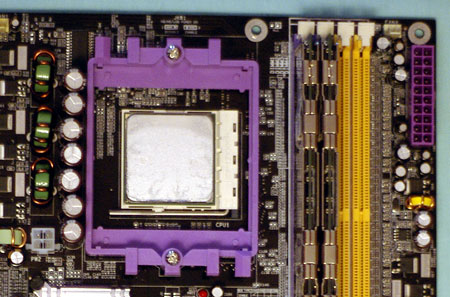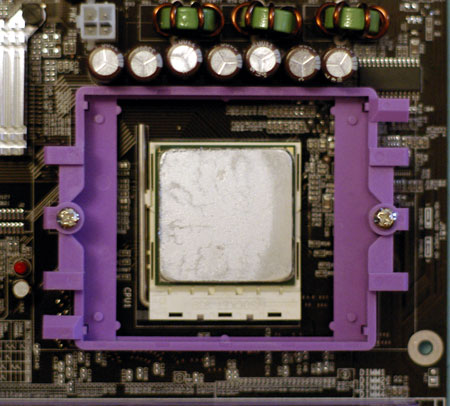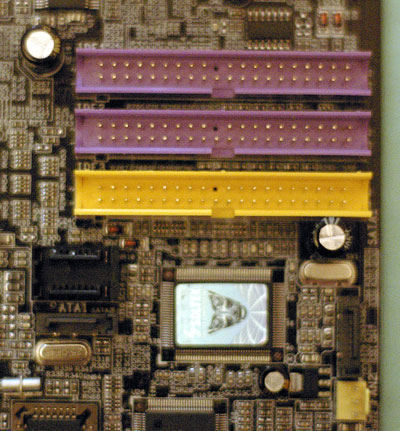Soltek K8TPro-939: Moving A64 to 939
by Wesley Fink on October 28, 2004 12:05 AM EST- Posted in
- Motherboards
Board Layout: Soltek K8TPro-939
Recent Soltek Pro boards have sported black and purple as their color scheme. The K8TPro-939 continues that design with a black board, purple slots, and coordinating purple cables.
The basic layout of the Soltek is excellent, better than most recent 939 boards that we have evaluated.

The ATX 20-pin and the 4-pin 12V connector are in near ideal locations on the K8TPro-939. The bulky 20-pin ATX is located on the preferred top right edge of the motherboard. This location on the board edge rarely interferes with processor air flow. The 4-pin 12V is also best on the upper right edge, but on the Soltek, the 4-pin power connector is placed between the CPU and IO ports. While this cable is smaller, it still needs to be routed past the CPU with care. This is not a great location for the 12V, but we had no real issues in our case setup. A better location would have been the top board edge or upper right board edge. Soltek did get the bulky 20-pin out of the way and that is more than what many designs do.

The CPU socket is in the top center of the board. PCI slots are below the socket and memory is to the right of the CPU. There is plenty of room around the Socket 939, so most Heatsink/Fans should work fine. The only possible problem is the tall capacitors that line the left edge of the socket, which may interfere with large spread HSF designs.

The IDE connectors are in our preferred right edge of the motherboard, but they are below mid-line where they may be a reach in a full tower case design. Most case designs will have no issue with this location, however. The four SATA connectors are in the same area and they should be an easy set up. The only potential problem with the SATA location is that the long PCU cards in PCI slot 3 may be a tight fit with SATA drives connected.

The floppy connector is the only glaring fault in an otherwise decent layout. The location at the bottom right edge of the motherboard is terrible, and is a very long reach in most any case. In a full tower case, you will have to find a super long floppy cable to reach this location. Since many users no longer even use a floppy drive, this won't matter to them, but if a floppy drive is still part of your build, this location will be a challenge in some cases.

The Soltek arrangement for the AGP and 5 PCI slots is pretty standard. With most users skipping over the slot next to the VGA card for better cooling, this leaves 4 usable PCI slots. With a standard-width video card, you could use slot 5 in a pinch.
The option headers are mostly lined up at the bottom of the board edge, an out-of-the-way location. The audio connectors are an exception, located in the middle of the PCI slots. If you still use or need audio cables, you will have to be careful routing them in this busy area. A better location would have been above the PCI slots.










21 Comments
View All Comments
WT - Monday, April 11, 2005 - link
A Soltek response in the forums:http://forums.anandtech.com/messageview.aspx?catid...
horsefly24 - Tuesday, January 18, 2005 - link
Here is an update to the Soltek SL-KT8 Pro motherboard to the DDR400 bios problem http://www.soltek.de/soltek/download/download_all....bob661 - Tuesday, November 2, 2004 - link
#16I have one of those boards but haven't tried the hothardware.com suggestion. I don't feel comfortable with cranking my HT up to 230 just to see if the damn locks work. Also, I'm going to try lowering the HT multiplier to see if that might enable the lock. I just wish Anand was a bit more precise in explaining how he got his lock to work.
Schro - Sunday, October 31, 2004 - link
>We suspect that this generates enough US volume>that Soltek must wonder what the real value of
>a US distributor would be.
Soltek HAD an exclusive US distributor, a company doing business as "Soltek USA". They were one of the best distributors that I have ever dealt with (sent plenty of promo packs ;)... ). They called it quits because Soltek Taiwan sold direct to the Egg, who was supposed to be purchasing from the US distributor. This undercut Soltek USA's business, etc etc. Hence, they have been gone for over a year now.
Wesley Fink - Thursday, October 28, 2004 - link
#16 - We also tried 233 on the Soltek which also did not work.As for 939 reviews, the Gigabyte GA-K8NS Ultra-939 is a lower cost version of the GA-K8NSNXP-939, which we have already reviewed. Since we have already reviewed the flagship Gigabyte 939, we will not be reviewing the lower members of the same family. The same applies to the lower-featured versions of some MSI boards.
The Asrock is based on the Uli chipset, and it's a possible review for the future. However, with PCIe boards coming, an AGP/PCI board with both sockets 754 and 939 probably won't find a slot in our review calendar.
thebluesgnr - Thursday, October 28, 2004 - link
Another great review, thank you Wesley.About PCI/AGP lock:
"However, no matter what lower ratio we chose, the highest CPU clock setting that we could achieve with stability was 228"
Some VIA K8T800 Pro boards without working locks have PCI/AGP dividers for 233 and 266MHz "FSB". Have you tried going from 228 directly to 233 on this board?
About that, I remember the MSI K8T Neo2 review. You wrote:
"We have been assured that shipping K8T Neo2 boards will have working PCI/AGP locks and we are passing this information to you."
I've seen many people complain that their boards do not have working locks; I've read this in a review (HotHardware.com):
"From 200MHz to about 212MHz, the K8T seemed to function normally. But at speeds from 212MHz through 230MHz, the board occasionally wouldn't POST. Speeds above 230MHz consistently worked, but we weren't very confident in our particular board's overclocking ability."
It would be great if you guys could get one of these from retail channel (and not directly from MSI) to check this out and update that review.
Anyway, with this Soltek review there are only two socket 939 boards listed in newegg not reviewd by AnandTech: ASRock K8 Combo-Z (cheapest s939 mobo, by $31) and Gigabyte GA-K8NS Ultra-939. If you could let us know if you'll review them I'd appreciate it. ;)
Gnoad - Thursday, October 28, 2004 - link
If there eventually is a BIOS update to this board that fixes the AGP lock, anandtech really needs to do a second review, or at least an update. This board looks like my future purchase if there ever is a updated bios.KrazyDawg - Thursday, October 28, 2004 - link
With the newer Asus motherboards, you won't have a problem with resetting the CMOS. There's an option to load defaults in the BIOS and if you're overclocking with an Asus motherboard and it fails to POST, it will reset the values to the ones previously used before you made the adjustment.Aikouka - Thursday, October 28, 2004 - link
#3, that floppy location is a pain, because if you ever have to get to the BIOS reset jumper, it makes it a lot harder, especially if you have a large case. I have a Thermaltake Xaser III V2000A, and it's a fairly large case. So a lot of my cables are stretched as far as they can go (especially from the PCI IDE card) and the floppy cable is no exception. At one point, I wanted to reset the bios, because the board was acting funny, and this was made extremely difficult by the location of the floppy connector and the bios reset jumper's location. One of the two should be moved to allow easier access. Also, the front panel connectors (Power switch, etc.) are below that, putting even more tight cables in the way.Looking at the picture, the JBAT jumper is located right beside the floppy cable, making it a pain to work with anyway.
Just like on the SL-K8ANE2-GR the purple doesn't suit it very well.
Soltek is really good with customer support, though. I was having problems with my board and they even sent me a beta BIOS to try out. Responses came back within 3 hours (usually around 1 hour.)
Wesley, I don't know chip prices off-hand or anything, but I can't see how VIA's solution would add a great cost to the board when Chaintech sells a VIA ENVY pci sound card, which retails for $25 (retail) on newegg.
UnderScore - Thursday, October 28, 2004 - link
Wesley,I like that AT includes content creation & encoding tests and I realize that games are popular repeatable ways to stress test a system. Perhaps these MB reviews could be less focused on game performance and more on the MB's subsystems? Why not prove that the Gigabit LAN will be slower on the PCI bus rather than guessing that it will likely be slower. Am I to assume that USB, Firewire, Onboard digital I/O etc by default are all working perfectly if they are not mentioned? Testing & reporting of such items would make AT's testing methodolgy more balanced since just like #4 & #9 mentioned, not everyone is an overclocker & similarly not everyone plays games regularly (esp FPS).
In closing, I thank you for all the work that you do & I hope you take this constructively as I had not intended to slam you or AT.
Thanks,
James